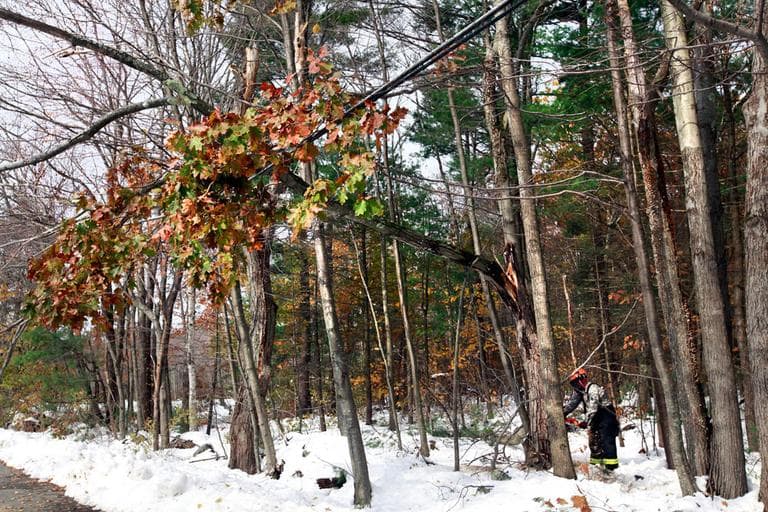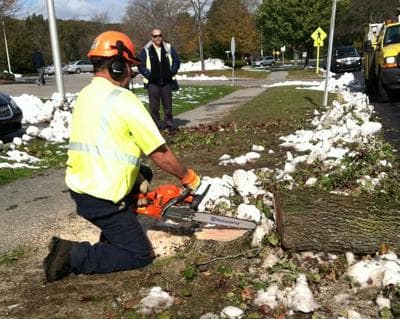Advertisement
Outages Lead To Questions On Tree Trimming
Resume
As hundreds of thousands of people in Massachusetts remain without power following the weekend snowstorm, electric companies are scrambling to reconnect them.
This storm was unique because it was so early in the season, with leaves still on the trees, which created so much weight that more tree branches fell. But some question whether the utility companies did enough tree maintenance before the storm to prevent the dramatic power losses.
'Tree City' Gets Hit Hard
The sound of a chainsaw is not something the townspeople of Lexington like to hear. The chainsaw I heard was cutting into the stump of a tree that fell into the street during the storm.
"We are passionate about our trees," said Town Manager Carl Valente.
Like most residents here, Valente is proud that Lexington was named “Tree City” for the 14th year in a row by the Arbor Day Foundation.

"Not only do we like our trees, we have a tree committee that keeps an eye on our trees, we have a tree manual that explains we should be planting our street trees and residents should be planting trees at their homes," he said.
But it's those trees and tree limbs falling on power lines that utility companies say have been the major cause of outages in Lexington and across Massachusetts. As of late Tuesday, a third of NStar’s customers in Lexington were still without power.
David Pinsonneault, the town's operations manager, says he's never seen such damage to the trees here.
"Most of them were still in full leaf and the way the storm came in with the heavy rains got everything wet, you got a lot of lush vegetation on them which put more strain on the limbs, then you had the wet snow on them — we’ve seen more devastation in this storm than those other storms," Pinsonneault said.
Vegetation Management
The utility companies are responsible for trimming trees around electrical wires on public lands. According to the Department of Public Utilities (DPU), the state agency that regulates power companies, NStar spent about $6.5 million on vegetation management in 2010.
But on Monday, NStar’s vice president of electric field operations, Craig Hallstrom, said they spend $14 million a year on a "robust tree trimming program." But he says they have to balance aesthetics with clearing the lines.
"Clearly the more you take, the better clearance, the fewer problems you’re going to have from the storms," Hallstrom said.
Rep. Dan Winslow, R-Norfolk, says NStar and the other power companies are not doing enough.
"If you drive through almost any community in Massachusetts and look up at the power lines you’ll see branches growing, not just alongside the wires, but through the wires in many of our towns," Winslow said. "That’s unacceptable. That’s sloppy maintenance, really."
Winslow accuses the utility companies of cutting back on tree trimming to save money. He says that has created a public safety threat. The DPU could not immediately assess whether or not power companies are spending less on tree cutting, but Secretary of Energy and Environmental Affairs Richard Sullivan says the DPU, which he oversees, is keeping an eye on that.
"The DPU monitors this and regulates this very closely," Sullivan said. "And obviously when you start to deal with streetscapes and many of the tress that are down are actually at people’s homes, and those are not going to be issues where the state is going to come in and regulate the trees in front of someone’s home."
National Grid spent $10 million last year on vegetation management, according to the DPU. Marcy Reed, the utility's Massachusetts president, defends its program.
"It's important that we spend that kind of money," Reed said. "It's not an area where we ever skimp, because trees can be your worst enemy when a storm comes by."
But cutting trees back can meet some resistance. When Nstar started trimming trees 10 feet around wires — instead of the usual eight feet — two years ago, Valente, Lexington’s town manager, says residents complained.
"It made it look like they were butchering the trees and we got considerable pushback from our residents about the amount of cutting they were doing," Valente said.
Valente would like the utilities to trim less, but more frequently. He says when this post-storm crisis has passed, he wants to sit down with NStar, the primary provider for Lexington, and talk about tree maintenance.
This program aired on November 2, 2011.